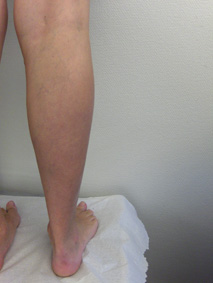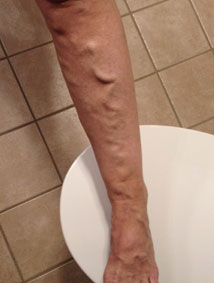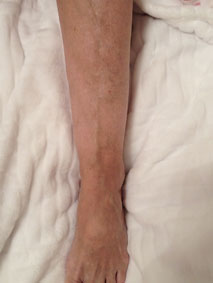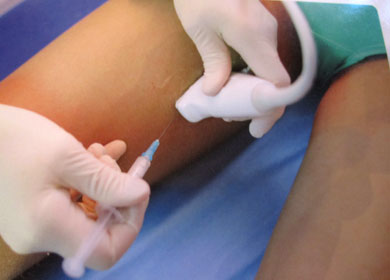About the treatment
Dr Galland Perhard uses a new treatment method consisting of foam injections into the varicose veins in combination with the use of ultrasound technology. The method is also known as echo sclerotherapy or duplex guided sclerotherapy.

Before

After
 Before
Before After
After Before
Before After
AfterAbout the history of the method

As early as 1946, Dr. Orbach discovered that a foam preparation was more effective in injection treatments of varicose veins. Later, the method has been refined, for example by the use of ultrasound. After around 1980, the method combining foam injection and ultrasound has come into use in many countries.
About the history of the method
As early as 1946, Dr. Orbach discovered that a foam preparation was more effective in injection treatments of varicose veins. Later, the method has been refined, for example with adding the use of ultrasound. After around 1980, the method combining foam injection and ultrasound started to be used in many countries.
What the method entails and how it works in brief
Using foam means that the drug takes contact with vein walls in a much more efficient way compared to traditional preparations. The drug affects the veins by creating a controlled inflammation, which the walls of the damaged vein cling together and atrophy.
Why is foam more effective?
Foam means that the drug is in contact with vein walls for twice as long as with traditional preparations. The drug affects veins by creating a controlled inflammation, which the walls of the damaged vein cling together and atrophy.
Differences as compared with traditional injection treatments
Traditional injection treatments cannot treat varicose veins that are not visible, and are only effective on small varicose veins and superficial spider veins. To be effective, such treatment must be followed by compression using surgical stockings or bandages over a long period of time.
With foam injection this is not necessary, and large varicose veins can also be treated.
Comparison with surgery
Using foam injections and ultrasound, it is possible to treat large, deep varicose veins, without general or local anaesthesia. The patient can walk normally soon after the foam treatment and can work as usual. There is no need for sick leave. The method is also much cheaper than surgery. There is no scarring and the risk for complications is much smaller.
Comparison with laser and radio waves
Methods using laser or radio waves cannot be used to treat all types of varicose veins. They can usually only be used to treat varicose veins on the inside of the thigh, above the knee and up to the groin. The varicose vein usually continues downward and will remain on the lower leg, the back of the leg and the outside of the leg, requiring treatment with some other method. The patient is unable to walk normally after the treatment and must often go on sick live. In addition, the cost is much higher than for foam injection.
How is the sclerotherapy performed?
The treatment using foam injection and ultrasound takes about thirty minutes. First, you look at the legs using ultrasound, to visualize varicose veins or to see if previously treated varicose veins have disappeared. The patient lies down on the treatment table and with the help of ultrasound, foam is injected straight into each varicose vein. There is no need for general or local anaesthesia, as the treatment consists of only a few pinpricks. There is usually no need for compression after treatment. The patient is recommended to walk and move normally after the treatment. Exercises such as heavy lifting, aerobic training or other strenuous activities should be avoided for about a week.
When will the patient see results?
As mentioned above, this treatment initiates a chemical process that lasts for about three weeks. You usually begin to see results after two weeks.


